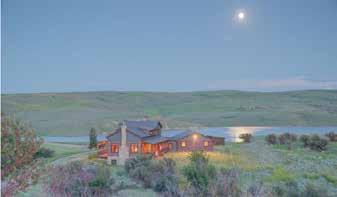
8 minute read
Driveway Planning and Building
PHOTOS BY KRISTEN SCHURR.
Rural living comes with its perks, but homeowners have a lot to consider when making that move to the country. Along with locating drainage and electrical, is designing a functional driveway. By Teresa Clark
The first step is determining what regulations the homeowner may need to follow. Jesse Tippmann, owner of Groundbreaking Construction in Piedmont, South Dakota, says homeowners who build in the country may need to obtain an approach permit with their county. An approach permit indicates where the county would prefer the entrance to the driveway be located, and if there is a particular setback.
Another consideration is storm water flows. “If a person has a piece of property and the only access to that property is from an existing road with a low spot, they may need to consider putting in a large culvert or some stabilization material, like large rock, in the soft or wet areas,” Tippmann explains.
Failing to consider low spots that can become flooded is one of the biggest mistakes Tippmann has seen landowners make when putting in a driveway. “In late August
DRIVEWAY planning and building considerations

One of the considerations in planning a driveway is considering what kind of vehicles the road will need to accommodate, how much they weight and how frequently it will be traveled.

or September, no one is thinking about spring rains because it is dry. They may not take into account that they are building their driveway in a low spot that will later hold water. When they drive around it and through it, the driveway will fail and rut up. You will lose your gravel and push it right into the muck. It is a loss of time, gravel and money,” he says.
Similarly, it’s important to observe where the snow typically blows, and lays. In some cases, a wellplaced curve or moving the driveway a few feet can help avoid snow removal issues.
How much will it cost?
Stability is crucial. Tippmann recommends building a driveway right the first time. “It might require investing a little bit more money, but in the long run, it could be beneficial and will prevent a lot of future maintenance,” he says.
When determining how much the driveway will cost, homeowners need to consider the length of the driveway. It determines the amount of material that will be necessary for the project, and how much topsoil will need to be stripped off.
The next consideration is determining the makeup of the subsurface material. If it’s clay, gumbo or sand, the homeowner may need to purchase four, six or 12 inches of stabilization material.
If the homeowner is building a driveway to a single family dwelling, only an eight to 12 feet wide driveway is needed. But if it is a rural ranch or farm where a lot of large farm equipment will be using the road, they may need a driveway that is 14-16 feet wide.

4791 COUNTY RD 29 SOLD! - SERVING WESTERN COLORADO -


Pick a material suitable for the area
In order to establish what material to use to build the driveway, the landowner will need to take a sample of the material that is just below the topsoil or sod. “In our area, we have varying materials from one mile to the next,” Tippmann says. “What I recommend is getting an idea of what the subsoil looks like six inches to a foot below the topsoil. The very best situation would be finding a gravely, sandy, stone-type material. If you’re dealing with a situation like that, less top material would be needed,” he says.
$1,250,000 MLS 160883 • 332 Acres
FCSAMERICA.COM NOBODY DELIVERS AG REAL ESTATE FINANCING LIKE FARM CREDIT SERVICES OF AMERICA. When it comes to ag real estate, there are
It’s Not Just a Ranch, it’s a Lifestyle.
more reasons to finance with us. Rates
are low, and we can fix the rate for the
entire life ofaloan — even on long-term
loans. With flexible repayment terms, a
money-saving WorkSmart ® line of credit


and cash-back dividends, our financing is among the most competitive you’ll find.
CALL TO LEARN MORE AT 605-342-0678. 2510 N Plaza Drive Rapid City, SD
TRI-STATE LIVESTOCK NEWS | THE FENCE POST Homeland SPRING 2020 33 Terms apply. See website for details.
1210 COUNTY RD 103 $785,000
MLS 162732 • 114 Acres 6 Beds • 2.5 Baths
However, if the subsoil is a clay or gumbo-type material, Tippmann says he would recommend a material like three-inch minus rock placed first, to a thickness of 4 to 6inches, and then topped with finer, three-quarter inch road gravel.
Located Southeast of Ellicott, easy access from Hwy 94


24830 Impala Circle 4 Bedroom | 2 Bathroom 2,027 sq. ft. | 6.26 Acres | $495,000


Gorgeous property in immaculate condition with an excellent opportunity or WATER. Located on 6-acres, this fenced property offers a beautiful home, oversized 3 Car Garage/Cleary Building, a 2-stall barn, 2 Tuff Sheds, a pergola, & animal shelters. The property has both DOMESTIC & IRRIGATION wells. The interior of the home offers an OPEN FLOOR PLAN, with a fabulous kitchen appointed with a large island, stainless appliances, a pot filler, & an over head vent. All the rooms are spacious, & there is central AC. This property has so much to offer for the farm/ranching lifestyle! Pikes Peak MLS# 7789429


Sue MyerS, ALC
Re/Max Real Estate Group 719-209-0364 Cell/Direct gorgeouscolorado.com
Preparation is important
Tippmann advises homeowners to make sure the topsoil and organic material is removed before putting down rock for a driveway. Topsoil can be squishy and soft, and as the organic material breaks down, it almost turns into a slime. “If you put the gravel right over grass, you are asking for future failure, possibly as soon as six months to a year,” he says.
“What we typically do is scrape off all the top soil and then build on top of the subsurface material. We loosen the subsurface, and then put rock on top of it. We pack the rock into the subsurface after we apply it,” Tippmann says.
Materials are readily available
Driveway materials, like crushed stone, are usually available. However, in Nebraska and some other areas, homeowners may opt for screened river rock. River rock is dug out of the ground and sized with a mechanical screen to make a consistent product.
If homeowners wish to use products other than gravel for their driveway, they may be looking at more expense. Tippmann says asphalt can cost around $6-$7 a square foot, installed, and 4 inches thick. “Heavy vehicles would be a concern with asphalt. Fourinch asphalt doesn’t typically hold up well under heavy tractors and vehicles,” he says.
For rural residents who live in areas where the soil is fragile, like the Nebraska Sandhills, options are available. One is Geotextiles, which can help stabilize roads that are susceptible to blowouts, sink holes, and ruts.
Geotextiles are similar in texture to a thick, heavy duty, feltlike material, Tippmann says. It allows water to travel through it, but locks the surface gravel together. Another type of Geotextile is a nylon mesh with three-quarter-inch square holes. Tippmann says both types of materials can last more than 60 years. “With the vinyl material, I don’t know if it would ever degrade,” he says. Geotextiles come in big rolls that are 12 feet wide and 200-300 feet long, and can be purchased at local contracting supply businesses.
The product can be used to bridge soft spots on the road. “We use it quite a bit in road construction if there is a soft spot or an area we can’t get to dry out. The Geotextile locks everything together,” he says. But, preparation is key. Tippmann recommends stripping off the topsoil before putting the Geotextile down, and then placing six inches of gravel over the top of it.
Helpful hints for DIY
For the do-it-yourself homeowner, building a driveway may seem a bit intimidating, but Tippmann says resources are readily available. “I would start with some of the local contractors. There are a lot of guys out there who are willing to come out to your home site and do a test hole for you. I have done that for people in the past to give them an idea of what the subsurface conditions are,” he says.
Many contractors are also willing to share their resources with a person who is trying to be a general contractor building their own home. “A contractor will be able to tell you where you can get gravel. That doesn’t necessarily mean that you have to hire them. There are a lot of people out there who are willing to give you a helping hand,” Tippmann says.









